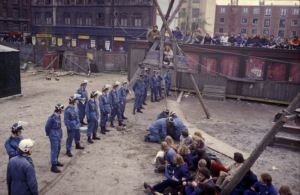Business & Education
The year the city fought the kids – and won
This article is more than 9 years old.
Built by the area’s residents on an empty lot, in the spring of 1980, Byggeren Playground in Nørrebro became the site of a bloody fight for survival

On April 29, 1980 the second policy action to remove Byggeren took place (photo: Søren Dyck-Madsen)
What would the kids – and their parents – fight for today? What injustice would be enough to kick them into action?
For the people of Nørrebro in 1980, the injustice worth laying down in front of a bulldozer came in the form of a slide and a couple of swings.
It all began with an empty piece of land in Nørrebro, Copenhagen’s working-class neighbourhood, notorious for decades for its slum housing. At the end of the 1960s, the city council started the ling task of tearing down many of this substandard housing to make way for newer apartment buildings, with inside toilets and larger living spaces, but by 1973 they had not yet built on much of the land they had cleared.
Weekend warriors
And so, one summer Sunday in June 1973, a group of residents were holding a party on the empty piece of land on the corner of Stengade and Baggesensgade. In the middle of the festivities, an inspired move brought a truck full of work tools, wooden boards and nails onto the land. For the rest of that Sunday the residents used the equipment to build a playground for the neighbourhood’s kids.
They called it ‘Firkantens Byggelegeplads’, the construction playground in the square, or in short, ‘Byggeren’.
Byggeren soon became very popular with the local children, many of them immigrants, and who for one reason or another did not attend state-run daycare. In May 1974 the municipality helped to make the place more official, with qualified staff hired to watch the children whose parents wanted to leave them.
Cold condemnation
But for all their hand-outs on the one side, the municipality had never quite forgotten their great building plan, something which started surfacing again in 1977. After seven years of threats, the razing of the playground was to become a reality.
In February 1980 the municipality decided to sign the death warrant once and for all. Staff and parents were told that the area would be cut in two, by 28 March for the first phase of building, while the rest would be allowed to remain until April 1981.
On 24 March, municipality construction crews ready to dismantle the climbing frame were met by defiant residents, who had formed a blockade in front of any demolition attempts. Realising they were going to require a lot more leverage to carry out their plan, on 22 April the first phase of demolition was carried out under the protection of 800 policemen.
Mowing them down
Despite their previous assurances to parents and staff, the municipality weren’t going to let this political hot potato linger and elected to continue with the final phase of demolition right away. For the activists, it was time to chain themselves to those swings.
On 29 April, under massive police presence, the unfortunate workers of the Midtsjøllands Demolition Company drove onto the playground, heads drawn. Those protecting the area had to leap for their lives to avoid being mowed down by the steady progression of the bulldozers.
Now, several thousand residents and protestors had come out to form a long line down the main thoroughfares of Nørrebrogade and Åboulevard. Between 70 and 100 arrests and charges of public disorder or ‘violence against an official servant’ put 14 in isolation for a week. When the police finally pulled back, 1,000 tenacious residents and their kids began rebuilding the playground with material from the demolition site.
Waging war
The tabloids called it ‘war in the streets’. All the way down Nørrebrogade to the lakes, fires were being lit, heads were bloodied and a state of unrest reigned for much of the night.
After a relatively calm couple of days – and an emergency meeting at City Hall – the 2 May brought a massive number of police into the area, removing the barricades erected around Byggeren, and on 4 May over 1,000 policemen, most of them in full riot gear, assisted demolition men in their task of tearing down the rest of the homemade playground.
The municipality’s betrayal resulted in an explosion of anger and violence in the surrounding streets. Over that afternoon and long into the night, the constant confrontations between residents and police rocked Nørrebro.
No mercy
Police had apparently changed strategy since the chaos of the week before, systematically hunting down the perpetrators with dogs and motorbikes along Nørrebrogade and down its many side streets.
On 5 May, as many as 15,000 people marched from Nørrebro to the Town Hall Square in a show of support for Byggeren. But the municipality was adamant. The playground lost.
The area still has one green space around the new flats that now cluster around it, the aptly named Folkets Park, or People’s Park. There is even film footage as well as still photos of those bloody days, where, despite all those flared trousers, sheepskin coats and bearded fathers, there remains amazement that the simple wish for children to have somewhere to play could inspire such desperate action.










































